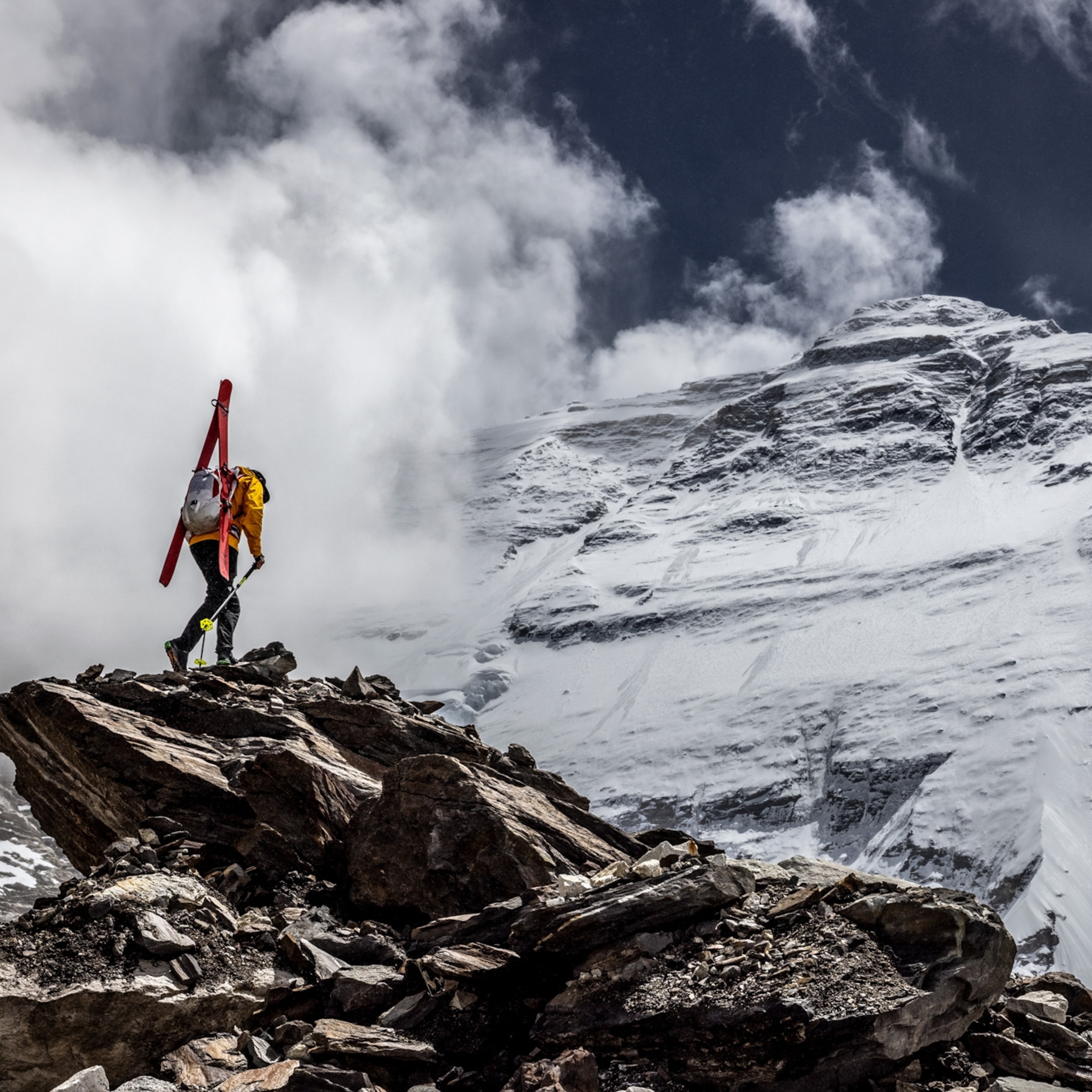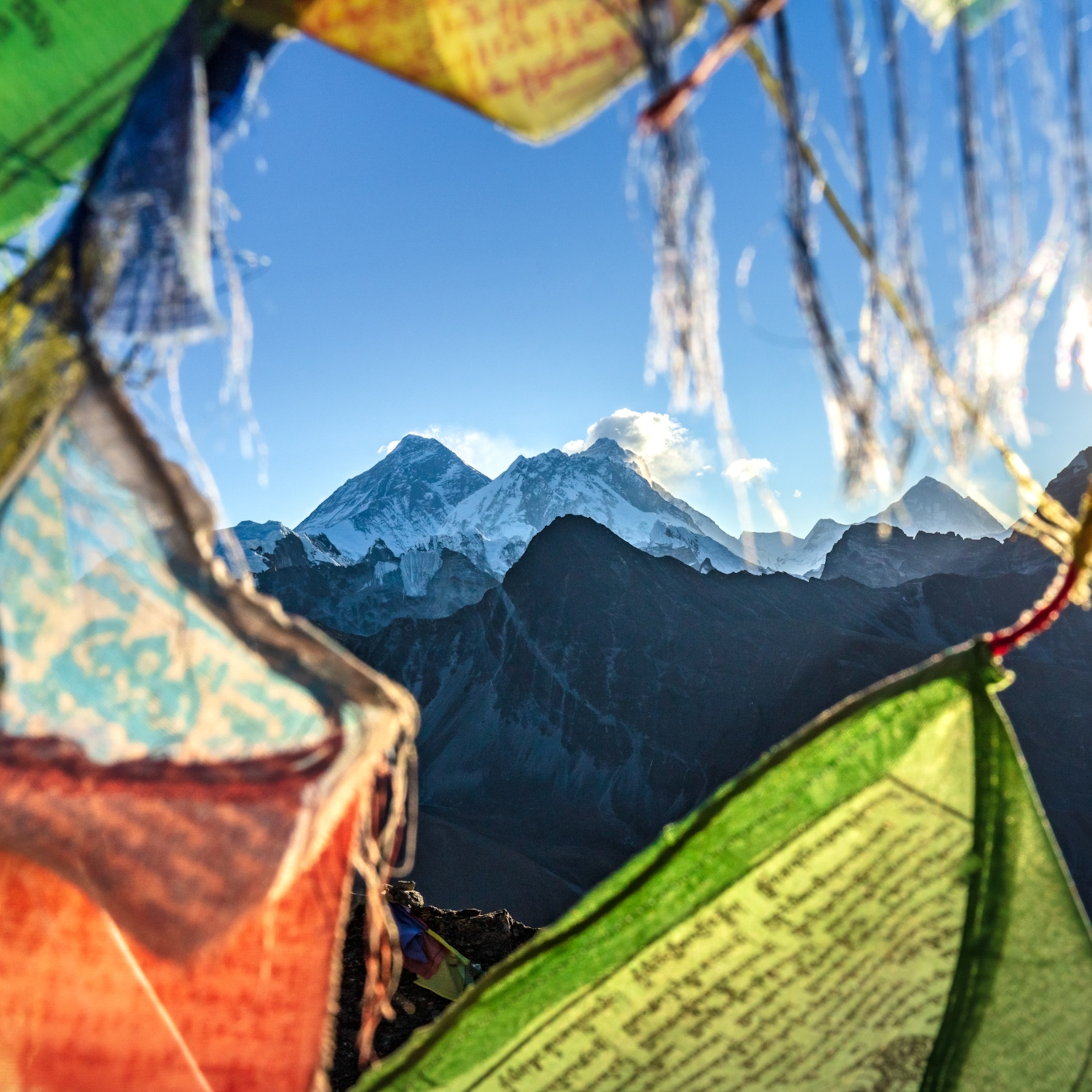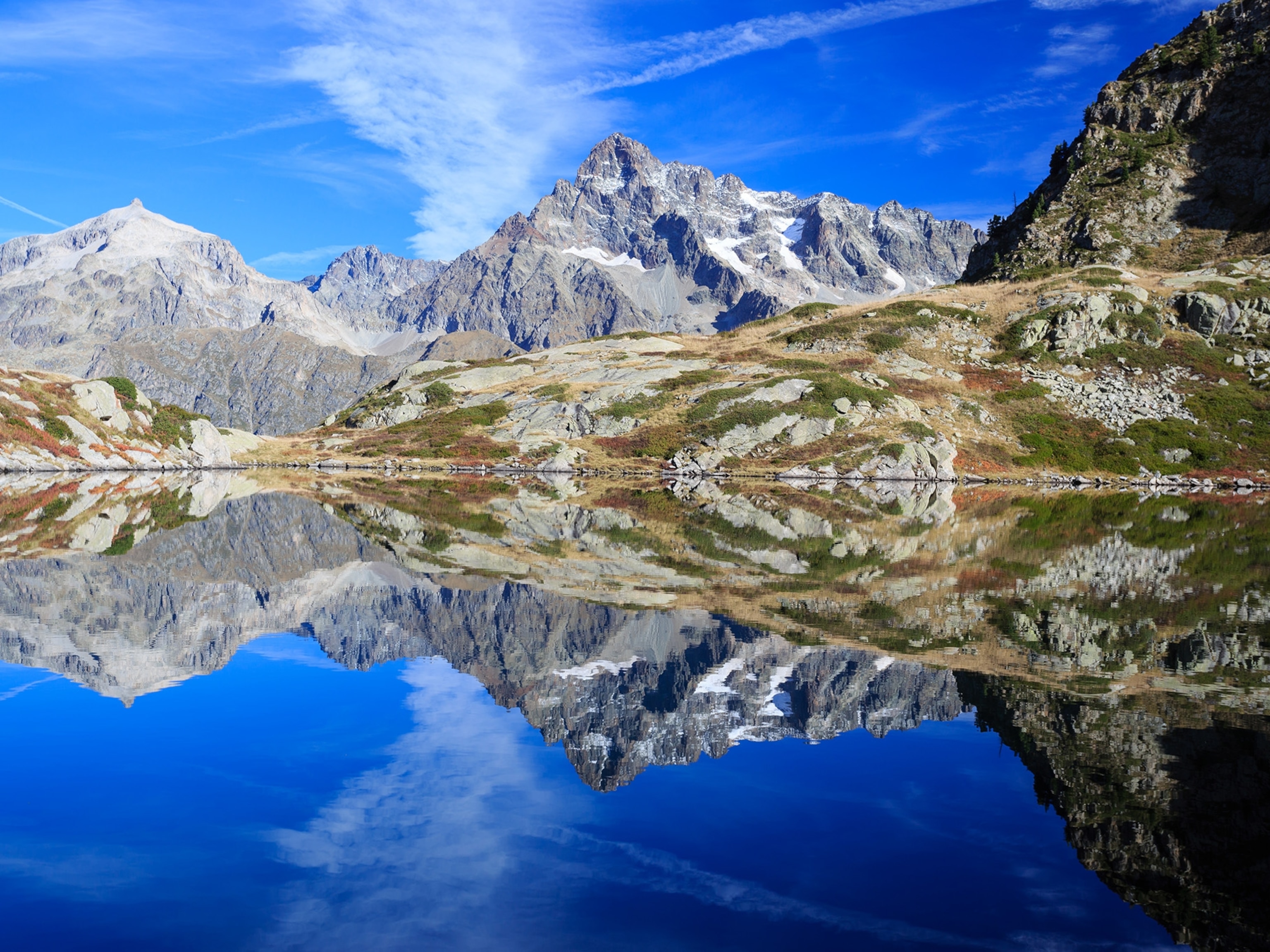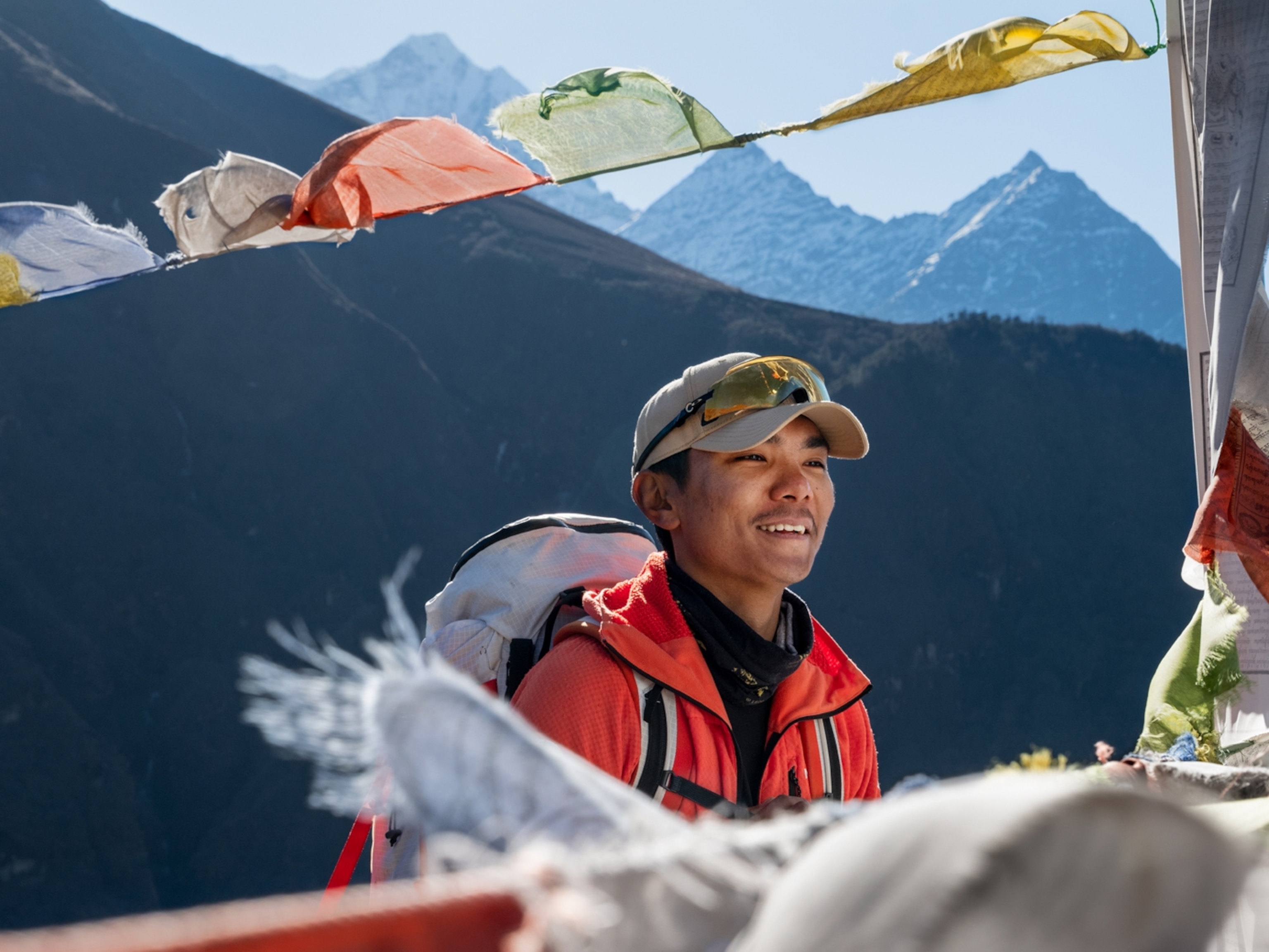
The Ups and Downs of a Top Woman Mountaineer
Melissa Arnot has summited Mount Everest six times—most recently without supplemental oxygen—and made a career of achieving big goals. Her next challenge: elevating the next generation of female climbers.
Atop Mount Everest’s 29,035-foot (8,850-meter) summit, Melissa Arnot dropped to her knees, bowed her head to the ground, and offered up a silent prayer of gratitude. It was May 23, 2016, and after seven years, three previous attempts, and fourteen straight hours of climbing, the 32-year-old mountain guide had reached the top of Everest without the use of supplemental oxygen, a feat that that only 200 of the more than 7,001 Everest summiters have ever accomplished.
After 15 minutes on top of the world, Arnot began her descent. Eight hours later when she reached camp at 24,934 feet (7,600 meters) she became the first American woman—and only the seventh woman ever—to successfully summit and descend Mount Everest without supplemental oxygen, one of the last big prizes for American female alpinists. She’d also notched her sixth Everest summit, the most of any Western woman. Needless to say, Arnot had cemented her place in Himalayan record books.
“There are so many reasons why Melissa's accomplishment is so impressive, especially considering the effort, both physical and emotional, that she's put forth over the years to make this happen,” says the professional climber and photographer Cory Richards, Arnot’s Eddie Bauer teammate who also summited Everest without supplemental oxygen in May 2016. “The mental fortitude that it requires is something very few people possess.”
That’s because climbing Everest without supplemental oxygen, or Os as it’s called in mountaineering jargon, is significantly harder and more deadly. “Climbing to these altitudes without oxygen is the same as suffocating at sea level by putting a plastic bag over your head that allows just enough air to survive,” says Peter Hackett, M.D., director of the Institute for Altitude Medicine. As such, the death rate for those climbing without oxygen above 26,000 feet (7,925 meters) is at least five times higher than for those climbing with Os.
A Climber Is Born
What makes Arnot’s accomplishment all the more impressive is the fact that she did not start climbing until she was 19 years old. Born in Colorado, Arnot grew up on the Southern Ute Indian Tribe Reservation in Ignacio, about 20 miles (32 kilometers) southeast of Durango. Her mother was an administrative assistant for Volunteers of America and her father worked as a ski patroller at Purgatory Resort and ran a construction business until he broke his back when Arnot was five. Then he began working as the director of the reservation’s housing authority. Money was tight, and climbing mountains wasn’t even a blip on young Arnot’s radar.
At 12, she and her family moved to Whitefish, Montana. The move proved difficult for Arnot, who left Colorado as a seventh grader and started school in Montana as a freshman in high school due to a combination of her smarts and discrepancies in the two school standards. Her family’s financial situation was amplified against the backdrop of Whitefish’s wealthy resort community, which made Arnot a target for bullies.
“When we went to Whitefish, we were really poor compared to everyone else. I’d never heard of Tommy Hilfiger or Doc Martens, and the first week of school I was getting made fun of for my Tweety Bird T-shirt,” she says. “I had Payless shoes and I sewed a Nike logo on them, because I realized that’s how you were cool in school—by having brand name clothes and I absolutely didn’t. That was a whole different kind of hard.”
Arnot was unhappy in high school and motivated to get out of there as soon as possible. She took college-level classes and graduated by the time she was 16. She also earned a scholarship to the University of Iowa, where she headed in the fall of 2000 to study literature and creative writing before deciding to pursue a business degree.
Shortly after graduating college at 19, Arnot headed back to Montana, where a friend invited her to climb the Great Northern Mountain, a non-technical, 8,705-foot (2,653-meter) peak outside of Glacier National Park. The experience opened up her eyes to the world of possibility that the mountains might hold for her.
“We went and bagged this peak and it totally changed my life,” says Arnot. “I’ve always been really empowered as a human. Even when I was really, really little, I knew that if I wanted something I could achieve it, but knowing what you want is a whole different thing,” she says. “The mountains were the first time I really felt like this is what I want. I am athletic but not competitive, and the mountains are that exact thing. That was where I felt home for the first time.”
After that first climb, she dedicated herself to learning how to climb and move through mountains, all while working at a health club and as an EMT in Montana. By 2004, she’d landed a job with RMI Expeditions guiding on Mount Rainier. Four years later, she was leading clients to the top of the world, kicking off a long and complicated relationship with Everest.
It was during her second trip to Everest for the 2009 Return to Everest expedition that she first set her sights on a no-Os attempt, which some alpinists consider a purer style of climbing. From the outset, claiming a record wasn’t the goal; testing the outer limits of her potential was. “At the time, I didn’t know that no American woman had climbed and successfully descended without Os. I was just curious if I could do it,” says Arnot.
However, while hiking into Everest Base Camp that year, she hurt her leg and wasn’t able to climb without oxygen. That was followed by two more thwarted no-Os attempts, including one in 2013 in which she nearly made it to the summit, but was forced to take oxygen at 27,900 feet (8,504 meters) after growing cold while helping another climber.
Controversy
In the years she was pursuing an oxygen-free summit, she was also flirting with another high-altitude achievement: the most Everest summits by a woman. The record first came into view after her third summit in 2010.
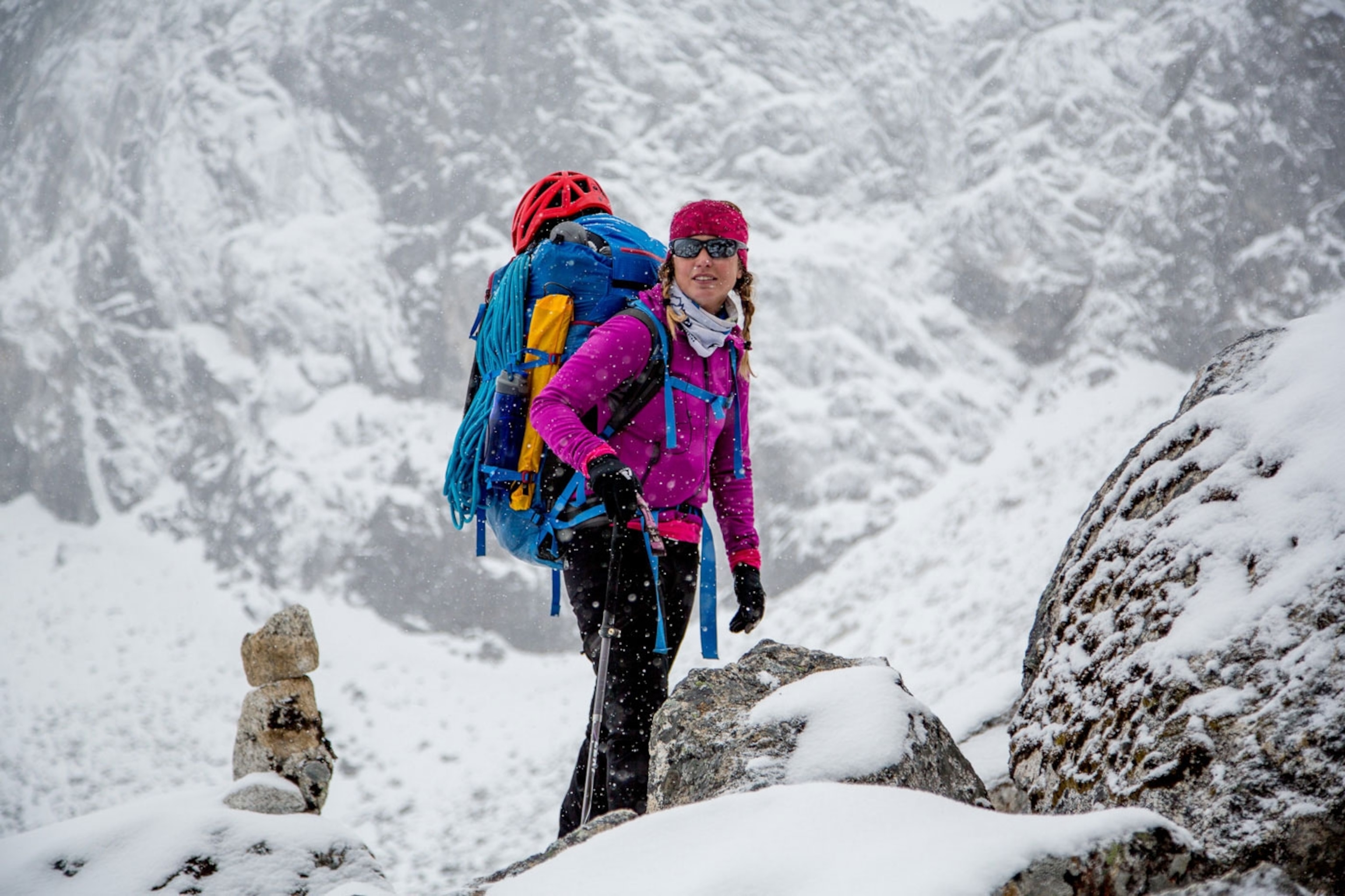
“In 2010, I went to Elizabeth Hawley [the Himalayan record keeper] and we were asking her about the summit. She said, ‘No, I don’t think there’s any woman who has more than two, so if you have three, you would have the most.’ I said, ‘I heard there’s a Sherpa.’ But Ms. Hawley said, ‘No, I don’t think so, but I’ll look into it.’ We never heard anything back,” Arnot says. Hawley, now 92, says she doesn’t recall the conversation with Arnot.
After reaching her fourth summit in 2012, Arnot believed she’d nabbed the record and the feat was promoted on her website and by her sponsors. However, the claim was inaccurate—and it wasn’t long before it ignited controversy. That’s because Lhakpa Sherpa, a Nepali woman who now lives in the U.S., had six summits at the time. (In May 2016, she notched her seventh Everest summit, the most of any woman on the planet.) “As soon as we found out that Lhakpa might have more than me, we took it down,” says Arnot. “I think it’s great a Sherpa woman has the record and it’s not even a thing between Lhakpa and me.”
It was an unfortunate—and innocent, according to Arnot—mistake, but the episode continues to dog her. “Arnot would have been much more respected had she not stolen the show of Lhakpa Sherpa for four years when she gallantly advertised herself as ‘Highest female record holder for Everest’ on her website!” Tsering Lhamo posted in response to a National Geographic Adventure article about Arnot’s 2016 climb.
And that’s not the only criticism that’s been lobbed at Arnot over the years. Despite her obvious talent and devoted work ethic, she’s been accused of benefitting from her good looks and lacking technical mountaineering skills, which brings to light the often unfair scrutiny to which female mountain athletes are frequently subject.
“One thing that I’ve felt is that, as a woman, your abilities and professionalism have to be so above and beyond what people expect of you, and that’s not fair. I’ve received criticism from people who say, ‘Oh you’re not the best mountaineer. You don’t do anything that’s technical or hard.’ I never said I was. I’m not Ueli Steck,” she says. “There’s this expectation that if people are paying attention to you as a female athlete it must be because you’re cute. Instead of supporting female athletes, there’s this attempt to debunk why they’re successful.”
Arnot’s experience in mountain sports encapsulates an uncomfortable reality: the unrealistic and often unfair expectations that are placed on female mountain athletes, one that their male counterparts aren’t exposed to.
"Professional mountaineers like Melissa are forced to be equal parts explorers and media personalities. And, for women, this includes the unavoidable casting as sex symbols and criticism when female athletes become parents, yet continue to take risks in the mountains,” says Ben Ayers, program director the dZi Foundation, a non-profit that helps remote villages in eastern Nepal. “She’s in a tough spot—she has worked extremely hard to simultaneously achieve success as a bad-ass climber, explorer, and agent for change within her industry. But it’s not enough to simply succeed in these realms. She, like most professional female athletes, is expected to be smoking hot too,” he adds.
A Respected Climber
In 2013, Arnot again landed in the center of another Everest controversy when she deescalated a fight that broke out on the mountain. While fixing ropes on the Lhotse Face, a Sherpa team felt disrespected by Jon Griffith, Ueli Steck and Simone Moro, some of the world’s top alpinists, who were also climbing the face that day. When the Westerners descended to Camp Two, a group of angry Sherpas enveloped them and threatened violence until Arnot intervened.
“At that moment, there was one person who helped to avoid the tragedy: Melissa Arnot, the famous alpinist from the United States. She was physically like a shield around us,” Moro told National Geographic in 2013. Arnot proceeded to facilitate a stand down that allowed the Westerners to leave the mountain with their lives.
Arnot was able to broker this peace thanks to her stature on Everest. Not only has she spent years developing relationships with the Sherpas working alongside of her, but in 2012 she—along with fellow guide Dave Morton—launched the Juniper Fund, a non-profit that helps the families of Nepali mountain workers who die on the job.
“She was respected as a climber since her first years on Everest because she was a paramedic and could help any Sherpa while climbing the mountain. She always took time to talk with local staff and she understands the local staff value on any expedition,” says Jiban Ghimire, the owner of Shangri-La Nepal Trek, a respected local outfitter. “She is very, very respected in the Sherpa community, especially after the Juniper Fund.”
The Juniper Fund grew out of Arnot’s experience losing Chhewang Nima Sherpa, her climbing partner and friend, on an expedition to 23,390-foot (7,129-meter) Baruntse in 2010. Chhewang Nima Sherpa was setting ropes high on the mountain with another Sherpa when the cornice he was standing on collapsed, killing him.
Soon after his death, Arnot met with his wife, who had relied solely on his income to survive, and Arnot was moved to help the family. “I couldn’t replace him, but I knew I could pay her, as long as I had a job, what he would have made. As I started doing that, it became really evident to me that it’s making an impact in her life,” says Arnot.
As Arnot began to witness the effect her cash contribution had on the lives of Chhewang Nima Sherpa’s family members, she realized that she wanted to help more families and she launched the Juniper Fund in 2012. Today, the Juniper Fund supports 35 families and owns three restaurants in Kathmandu, which are run by widows. They’re also preparing to buy a beauty parlor and salon where two other women will work.
Looking back on the 2013 incident, Arnot acknowledges that it was one of the darkest days in the mountain’s history, but she also believes there’s a silver lining. “One thing that’s positive to come out of that is that everybody is more sensitive now to how we treat each other,” she says. “Ultimately that’s going make Everest a better place to be for everybody.”
Setting a Record
This year, Arnot again returned to Everest, but this time in a fashion far different than in years past. After spending the spring in the Himalaya mentoring a 13-year-old American girl, on April 29 Arnot and her fiancé Tyler Reid, a Washington State-based mountain guide, secretly headed to Everest’s north side, a first for Arnot.
As she headed to Tibet, she cut off contact with the outside world. Aside from her business manager, she told no one—not sponsors nor her family—of her plans. Her social media channels went dark and she denied to reporters that she was heading to Everest. “For me in years past, media coverage has been super distracting. I felt like checking out completely was the right thing to do,” she says. “It was such a dangerous, big goal that I wanted to be sure that I wasn’t doing it to receive accolades from the public. If I was going to try it, I wanted to try it because it was something that meant something to me. I felt like I had to feel like I would want to do it if no one would ever know that I did it,” she says. She says she needed to tune out all the noise in order to focus deeply on her dream.
- National Geographic Expeditions
Over the years, she’d spent time crystalizing in her head what exactly was driving her to climb without Os. Was it an ego thing? Was it about nabbing the American record? Or was it about something deeper?
She’d spent four years dialing in her true motivation. In 2012, Arnot, who had set her sights at that point on a no-Os summit, was guiding on Everest when the professional mountaineer Hilaree O’Neill arrived on the mountain, eyeing an oxygen-free ascent—and the record for the first American woman to climb without Os.
“Being the first as my motivation was something I really had to deal with in 2012. I had to look that in the face and say, ‘If Hilaree O’Neill climbs it first, am I still going to pursue this goal? Or if some unknown woman comes and climbs without oxygen is that going to change why I’m doing this? If it is, why am I doing this and is that the right motivation?” Arnot explains.
The soul searching ultimately led Arnot to realize that the climb was about something greater than an accolade on her resume. “I’ve done a lot of work on why I’m doing this and being first to me honestly wasn’t the driving factor. I just wanted to challenge myself personally and see if I could.”
On May 23, Arnot stood atop Everest. It was sunny and clear there above the clouds. Tibetan prayer flags draped the snowy summit. After offering up her gratitude to the mountain, she called her best friend-turned-business manager with an update on her progress. “I reached the summit and I’m not using any oxygen.” Then, tears began to stream from her eyes. So much of Arnot’s life has been about stretching the boundaries of her abilities, and in this instance, she’d also pushed up against the outer limits of the human spirit.
A New Challenge
On August 7, Arnot and Maddie Miller, a 21-year-old college senior, climbed to the top of 13,796-foot (4,205-meter) Mauna Kea on Hawaii’s Big Island. It was sunny and cool, and a low-lying blanket of clouds obscured the desert landscape thousands of feet below them. Atop the peak, surrounded by family and friends, the women hugged and kicked handstands. They had reason to celebrate: they’d just finished the 50 Peaks Challenge, a project in which Arnot and Miller had climbed the highest peak in every state in record time.
Kicking off on June 27 with Miller’s summit of Denali, which Arnot was forced to miss due to a cold injury on her foot that she’d sustained on Everest, the women climbed 84,275 feet (25,687 meters), hiked over 268 miles (431 kilometers), and traveled close to 20,000 miles (32187 kilometers) in a souped-up sprinter van across 50 states in just over a month. In the process, Miller set a new world record, notching the feat in 41 days, 16 hours, and 10 minutes, besting the previous record by two days.
The sheer conquest aside, the 50 Peaks project was a continuation of Arnot’s commitment to mentoring the next generation of female climbers. Over the last year, she has begun to work with several young women, many of whom are the children of former clients. Arnot had no mentors, let alone female ones, when she was coming up as a climber, and inspiring women through her own staggering feats and helping them cultivate their skills in the mountains is a newfound joy.
“It’s been an incredibly rewarding thing,” says Arnot. I want them to know what’s possible for women to achieve. I don’t want to be the anomaly,” she says. “I also want them to know that I don’t see myself as exceptional in any real way and anything is possible for them too. I work hard. I choose goals and I pursue them very intentionally. There’s no reason they can’t achieve anything in their lives that they want. It’s so cool to in practice show other young girls that. It’s been a really powerful thing for me,” she says.
For now, in terms of big mountain ambition, Arnot says she’s not sure what her future holds. At the moment, she’s content to let the recent accomplishment on Everest seep in.
“I want a moment to enjoy this, this huge career achievement. I’ve been in such pursuit of one single goal for so long that I feel like to just move on to the next thing is disrespectful to my goal and how hard I worked for it,” she says. “But I’m also an incredibly reactive goal setter. I see something and then I just pursue it. So now that the 50 Peaks project is done, who knows?”
